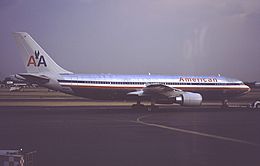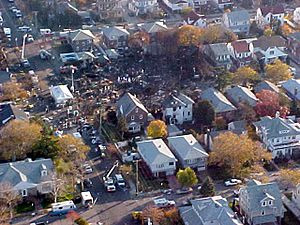American Airlines Flight 587 facts for kids

N14053, the aircraft involved in the accident, picture taken in Mexico City one year and eight months before the accident.
|
|
| Accident summary | |
|---|---|
| Date | November 12, 2001 |
| Summary |
|
| Place | Belle Harbor, Queens, New York City, New York, United States 40°34′38″N 73°51′02″W / 40.57722°N 73.85056°W |
| Passengers | 251 |
| Crew | 9 |
| Fatalities | 260 |
| Survivors | 0 |
| Aircraft type | Airbus A300B4-605R |
| Airline/user | American Airlines |
| Registration | N14053 |
| Flew from | John F. Kennedy International Airport New York City, United States |
| Flying to | Las Américas International Airport Santo Domingo, Dominican Republic |
American Airlines Flight 587 was a regular flight from John F. Kennedy International Airport in New York City. Its destination was Las Américas International Airport in the Dominican Republic. The plane used was an Airbus A300-600. On November 12, 2001, the aircraft crashed into the Belle Harbor neighborhood of Queens, New York. All 260 people on the flight died. Five people on the ground were also killed.
The crash happened because the plane's tail broke off. This was due to the pilot making too many strong rudder movements. These movements happened while the plane was flying through wake turbulence. This is like a mini-tornado of air that forms behind another plane. This accident is the second-deadliest plane crash in the United States. It happened after American Airlines Flight 191 in 1979.
The accident took place just two months after the September 11 attacks on the World Trade Center. Because of this, many people first thought the crash was caused by terrorism. However, investigations later showed this was not the case.
Contents
The Aircraft and Its Passengers
| Nationality | Passengers | Crew | Ground | Total |
|---|---|---|---|---|
| 159 | 9 | 5 | 173 | |
| 68 | 0 | 0 | 68 | |
| 5 | 0 | 0 | 5 | |
| 3 | 0 | 0 | 3 | |
| 2 | 0 | 0 | 2 | |
| 2 | 0 | 0 | 2 | |
| 2 | 0 | 0 | 2 | |
| 1 | 0 | 0 | 1 | |
| 1 | 0 | 0 | 1 | |
| 1 | 0 | 0 | 1 | |
| 1 | 0 | 0 | 1 | |
| 1 | 0 | 0 | 1 | |
| 1 | 0 | 0 | 1 | |
| 1 | 0 | 0 | 1 | |
| 1 | 0 | 0 | 1 | |
| 1 | 0 | 0 | 1 | |
| 1 | 0 | 0 | 1 | |
| Total | 251 | 9 | 5 | 265 |
American Airlines Flight 587 was an Airbus A300B4-605R. Its registration number was N14053. The pilots were Captain Edward States, 42, and First Officer Sten Molin, 34. The First Officer was flying the plane at the time.
Most of the people on board were Americans. However, 68 passengers were from the Dominican Republic. There were also people from many other countries. These included Indonesia, Taiwan, Canada, Australia, Brazil, France, Germany, Haiti, Italy, Japan, the Netherlands, Israel, Mexico, the United Kingdom, and Switzerland.
The Flight's Journey
Flight 587 was supposed to leave John F. Kennedy Airport at 8:00 AM. It was heading to Santo Domingo in the Dominican Republic. Boarding took a bit longer than usual due to extra security checks. The plane pushed back from the gate at 9:00 AM.
The crew then moved the plane to Runway 31L. They were behind Japan Airlines Flight 047, a Boeing 747-400. This larger plane was going to Tokyo, Narita. Japan Airlines Flight 047 took off at 9:11 AM. As the 747 climbed, the control tower warned Flight 587's pilots. They were told about possible wake turbulence from the bigger plane.
At 9:13:28 AM, Flight 587 was cleared for takeoff. It left the runway at 9:14:29 AM. This was about 1 minute and 40 seconds after the JAL flight. The plane climbed to 500 feet. Then, it started a climbing left turn.
What Went Wrong
At 9:15:36 AM, Flight 587 flew into the wake turbulence from the JAL flight. The First Officer tried to keep the plane steady. He moved the rudder pedals aggressively from left to right. This went on for about 20 seconds.
At 9:15:56 AM, the strong and repeated rudder movements caused too much stress. The parts that held the vertical stabilizer and rudder broke. The stabilizer then separated from the plane. It fell into Jamaica Bay, about a mile from where the main wreckage landed.
Eight seconds later, a stall warning sounded in the cockpit. When the stabilizer broke off, the plane suddenly pitched downwards. The pilots tried hard to control the plane, but it went into a flat spin. The forces on the plane were so strong that both engines broke off. They landed several blocks away from the main crash site. Losing the engines cut off power to the flight recorders. The plane crashed moments later.
The main part of the plane hit the ground in Belle Harbor. It crashed on Newport Avenue and Beach 131st Street. Three houses were immediately destroyed. All 260 people on the plane and five people on the ground died. The impact and the fire after the crash destroyed the wreckage.
The Investigation Findings
The National Transportation Safety Board (NTSB) led the investigation into the crash. They are the main group that investigates plane crashes in the U.S.
The NTSB concluded that the plane's vertical stabilizer broke off because of extreme forces. These forces were caused by the First Officer's "unnecessary and excessive" rudder pedal movements. The way the A300-600 rudder system was designed also played a part. Also, some parts of American Airlines' pilot training program contributed to the problem.
- NTSB Accident Report on AA 587PDF (1.86 MB)
Images for kids
-
Flight 587, circled in white, moving downward with a white streak behind the aircraft at 9:16:06, from a video of a toll-booth camera on the Marine Parkway–Gil Hodges Memorial Bridge
-
The accident aircraft taxiing to runway 31L at 8:59 am, moments before takeoff: The timestamp shown in the picture is an hour ahead due to daylight saving time.
See also
 In Spanish: Vuelo 587 de American Airlines para niños
In Spanish: Vuelo 587 de American Airlines para niños






